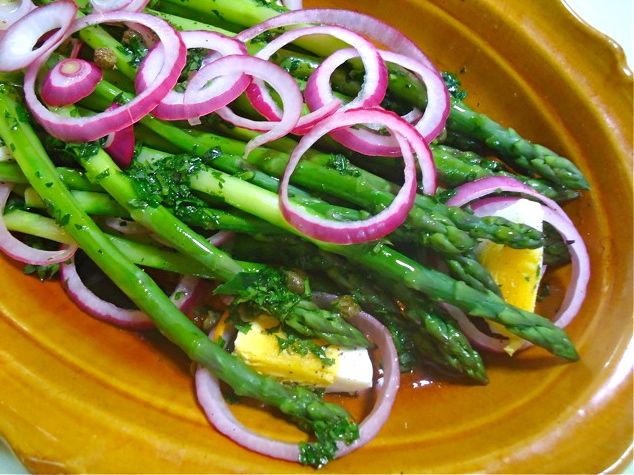
reference-image, l
(article, Deborah Madison)
[%adInjectionSettings noInject=true][%pageBreakSettings nobreak=true] In 1993, Crayola named one of its pigments “asparagus”; it is number 26 in a boxed set of 96 crayons. Of course it was green, but a rather quiet, dull green. Green, in some shades, is a pretty common color for vegetables; the chlorophyll they contain makes them so. But asparagus can be colors other than green alone. Coming up in the field, it can appear almost brownish at first, or a dark dusky purple. If banked with soil to keep the spears from the light, asparagus will be a pale, anemic white, which is not to say it isn’t regarded as a delicacy — it is, especially in northern Europe. (Personally, I like mine with the chlorophyll included.) Once peeled and simmered, the green goes from dull or purplish to translucent and brilliant — the color of new leaves on the trees, of spring herself. Green is never simple and, really, it’s impossible to limit it to one Crayola color. [%image reference-image float=right width=400 caption="Asparagus with Salsa Verde, Pickled Onions, and Quartered Egg"] Formerly classified as a member of the lily family, asparagus now has a family of its own, Asparagaceae, of which it is the sole member (Asparagus officinalis). It’s long been considered a delicacy regardless of its color or family ties. These days, asparagus turns up in U.S. markets more frequently than formerly, due in part to Peru’s entrance to North American markets. But that may not last much longer. In Peru, asparagus is grown in a desert so dry that it has to be watered year-around to ensure a steady supply. As a result, the region's water table has dropped so much that the largest town in the area, as well as individual farmers, are now without water. Despite the jobs that asparagus cultivation has provided Peruvians, it has over-consumed a far more valuable resource: water. This may ultimately prove its undoing as an export crop. We are all quite used to seeing the spears in every bunch of asparagus we buy be exactly the same length and the same thickness, as if they came up that way in orderly rows, which may be because that is what they do on commercial farms. But in your own asparagus patch, you might find that some are thick and chunky, others skinny, some short, and others shooting up fast and tall. No two spears are alike, but the flavor of garden “grass” is intensely green, a flavor most of us seldom really encounter. At the farmers market, asparagus is also of different lengths and thicknesses, and people have their favorites. Some prefer thin stalks, while others prefer those that are as large and fat as possible. Often, the farmers don’t take the time to bind them into bunches; they just put them in a cooler, and customers paw through the spears, choosing the ones that look good to them. The asparagus that I’ve picked along the acequia, or irrigation banks in Colorado and New Mexico, is as exciting to find as wild mushrooms. It can be very long if your timing is right; once you get it home, it seems to keep right on growing. We call it wild asparagus, but old timers say it’s garden asparagus that has escaped and settled along the water-filled ditches. Either way, it’s nothing to pass up. I was in North Carolina recently, and both ramps and asparagus were for sale at the tailgate farmers market. My friend and I sautéed and then braised the sliced ramps and asparagus together, throwing over some tender greens at the end. It was a simple and delicious dish. Since ramps are something of a rarity, here’s a dish that doesn’t require them. It’s a bright and cheerful salad that will feel like spring, even if the rain has returned. Asparagus with Salsa Verde, Pickled Onion, and Quartered Egg The pickled onion takes only a minute or two to make, so start with those, and they will have colored up by the time you're ready for them. Serve warm, at room temperature, or slightly chilled. And keep in mind that the sauce is also very good over grilled, roasted, or griddled asparagus. This recipe serves two generously. 1 small red onion, peeled and sliced into thin rounds Apple cider or rice-wine vinegar, a few tablespoons Sea salt and freshly ground pepper 1 pound asparagus Chopped parsley, about 3 tablespoons Chopped tarragon, about 1 tablespoon 1 tablespoon capers 1 wide band of orange zest, cut into fine slivers and blanched for 10 seconds 3 tablespoons olive oil 1 scant tablespoon vinegar (can be the same you used for the onions) 1 hard-cooked egg, quartered Separate the sliced onion rings and toss them in a few tablespoons of vinegar with a pinch of salt. Set them aside in the refrigerator. Trim thin asparagus by snapping off the woody, tough ends. If the asparagus is thick, slice off the butt end where it changes color and appears to be tougher. Peel the thick asparagus but not the thin. Simmer in a skillet of salted water until it is bright green but still a little firm, about 4 minutes for thin asparagus, 6 minutes for fat. Set the cooked asparagus on a towel to dry while you make the sauce. It will finish cooking as it does so. Put the parsley, tarragon, and capers in a bowl. Finely dice half the slivered orange zest and add it to the herbs. Stir in the oil and vinegar. Season to taste with salt and pepper. Spoon the sauce over the asparagus, then use your hands to turn the spears, to coat them on all sides. Garnish with the remaining slivers of orange peel and scatter the pickled onion rings over all. Tuck the egg quarters among the spears and onions and serve.

reference-image, l